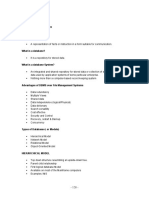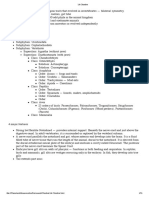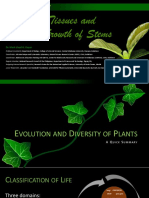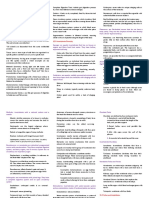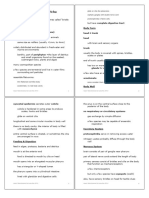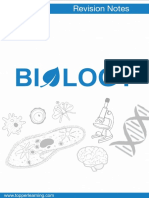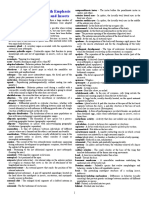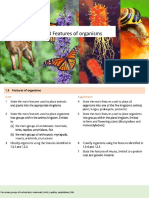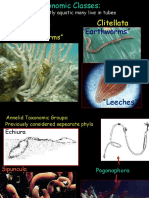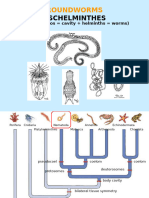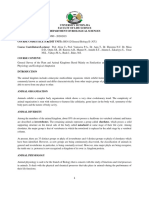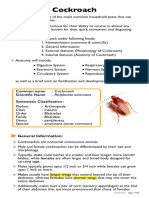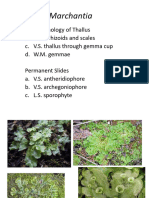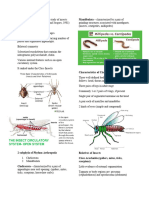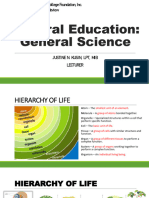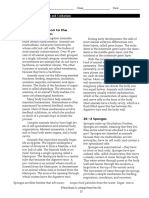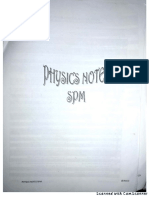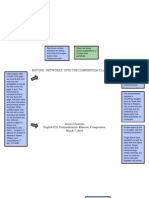Irregular Plurals Biology
Irregular Plurals Biology
Uploaded by
Nuan Ting NgCopyright:
Available Formats
Irregular Plurals Biology
Irregular Plurals Biology
Uploaded by
Nuan Ting NgOriginal Title
Copyright
Available Formats
Share this document
Did you find this document useful?
Is this content inappropriate?
Copyright:
Available Formats
Irregular Plurals Biology
Irregular Plurals Biology
Uploaded by
Nuan Ting NgCopyright:
Available Formats
Irregular Plurals in Biology/Zoology
Most English nouns are made plural by adding -s or -es to the singular form. However
there are many exceptions. The following table lists singular and plural forms of
scientific words that are exceptions to the general rule.
The definitions given in the glossary are very brief and incomplete. In the table, is an
alphabetized list of irregular plural terms used in the biological sciences. Fuller
definitions can be found in good biological dictionaries (e.g., Lawrence, Eleanor. 2005.
Henderson’s Dictionary of Biology, 13th edition. Toronto: Pearson/Prentice Hall) or a
relevant textbook.
The vast majority of irregular plurals are derived from Latin, the common scientific
language when the discipline of Biology first arose. Like many languages, Latin has
genders for nouns. Latin has three genders: masculine, feminine and neuter. Most Latin
masculine nouns end in -us and are pluralized -i (cactus/cacti); most feminine nouns end
in -a and are pluralized -ae (alga/algae); and most neuter nouns end in -um and take the
plural ending -a (agendum/agenda). These three rules will help you understand most of
the English exceptions. However, some of the nouns are derived from Greek or other
languages, some English nouns have no logical plurals, and some other nouns are
uncountable and have no plural form.
Regularizing or anglicizing plurals, by forcing an -s or -es onto many singular nouns,
often causes awkward pronunciations. Adding -s or -es to already plural nouns is simply
wrong. Adding Latin plural endings to non-Latin words is also wrong.
Words Used in More than One Sub-discipline of Biology
As Botany and Zoology evolved quite separately initially, many of the words have
different meanings in each sub-discipline. Also some words have the same foreign root
but slightly different English spellings.
Table 1 Biological Words
Singular Correct Acceptable Definition and Comments
Plural Plural
acetabulum acetabula acetabulums Anatomy: cavity on the side of
the hipbone.
Zoology: a round cup-shaped
sucker found on flatworms and
mollusks; thoracic cavity of
insects in which a leg is
inserted.
acinus acini tiny thin-walled air sac found in
large numbers in each lung
alga algae aquatic non-vascular
photosynthesizing organism;
formerly regarded as plants
alveolus alveoli tiny thin-walled air sac found in
large numbers in each lung
amnion amnia amnions the inner membranes enclosing
the embryo of a bird, reptile, or
mammal
ampulla ampullae ampullas a small container
androecium androecia male part of flowers
angiosperm angiospermae angiosperms vascular plants with covered
seeds
antheridium antheridia A reproductive cell containing
male gametes in algae and
fungi. In liverworts, mosses and
ferns, it is multicellular.
antrum antra cavity within a bone
aorta aortae aortas large blood vessel leaving the
heart
archegonium archegonia female organ in primitive pants
(mosses, liverworts, ferns, etc.)
areola or areolae areolas / Botany: space surrounded by
areole areoles hairs or thorns, small area of
leaf mesophyll surrounded by
veins. Zoology: circular
pigmented area around the
nipple of certain mammals, part
of eye iris, small pit.
atrium atria atriums open chamber, especially of the
heart
bacillus bacilli aerobic, rod-shaped, spore-
producing bacterium
bacterium bacteria (more microscopic organisms without
(one cell or than one cell a nucleus
one species) or species)
bronchus bronchi tube leading from the windpipe
to a lung
bursa bursae bursas a fluid-filled sac that reduces
friction around joints
cactus cacti cactuses succulent dicot plants adapted
for arid regions greatly modified
leaves; members of the family
Cactaceae
calyx calyces collective term for sepals
caryopsis caryopses/ a seed-like dry fruit containing
caryopsides a single seed
cava cavae the largest vein in vertebates
cecum ceca pouch in which the large
intestine begins
cerebellum cerebella cerebellums the part of the brain located
directly behind the cerebrum
cerebrum cerebra cerebrums the front part of the brain
cervix cervices cervixes body part that resembles a
neck in shape or function
chiasma/ Anatomy: any crossing over of
chiasmata biological tissue. Genetics: the
point at which two chromatids
join during fusion and exchange
of genetic material.
cilium cilia a short thread-like appendage
of certain cells
cisterna cisternae cavity containing fluid.
clitoris clitorides clitorises female erectile tissue
cloaca cloacae cloacas terminal region of the gut in
reptiles, amphibians, birds, and
many fish as well as in some
invertebrates
coccus cocci circular-shaped bacteria
coccus cocci circular shaped bacteria
concha conchae part of the body shaped like a
conch shell
corolla corollae corollas collective term for petals of a
flower
corona coronae coronas a crown-like structure
corpus corpora body of an organism; a
collection (body) of writings
cortex cortices tissue in plant stems and roots
between epidermis and the
central core
cortex cortices Anatomy: outer layer of a solid
organ or part of the body
crista cristae Anatomy: crest or ridge, the
border of a bone
Cell biol.: fold in the inner
membrane of a mitochondrion
culm culmina culms stem or straw of grasses
decidua deciduae specialized part of the mucous
membrane that lines the womb
during pregnancy
edema edemata abnormal swelling in a plant
caused by a buildup of excess
water
edema edemata Med.: abnormal buildup of
serous fluid between tissue
cells
endocardium endocardia thin membrane lining the heart
cavities
endoplasmic endoplasmic Internal membranes of cells;
reticulum reticula often abbreviated as ER
endothelium endothelia layer of cells that lines the
inside of certain body cavities
epididymis epididymides coiled tube that stores sperm
epithelium epithelia epitheliums a thin layer of tightly packed
cells lining internal cavities,
covering exposed bodily
surfaces
esophagus esophagi the passage between the throat
and the stomach
fascia fasciae fascias sheet of connective tissue
covering parts of the body
fauna faunae faunas collective tern for animals in an
area
flagellum flagella flagellums a long lash-like appendage of
certain cells
flora florae floras collective term for plants in an
area
folium folia
foramen foramina foramens natural opening through bone
or cavity
fornix fornices Anatomy: structure or fold in
the shape of an arch
fossa fossae hollow, pit, or groove in a part
of the body
frenulum frenula small fold of skin or membrane
that limits the movement of an
organ
fruit fruit fruits (when mature ovary containing seeds
concerning
several kinds
or species)
fungus fungi funguses group of organisms without
chlorophyll that obtain nutrients
from organic matter
ganglion ganglia ganglions dense cluster of nerve cells
gastrula gastrulae stage in embryonic
development
gemma gemmae a budlike, asexual structure
genitalium genitalia genitals external components of
reproductive organs
genus genera a grouping above species level
gingiva gingivae gum around the roots of the
teeth
glans glandes erectile tissue of a penis and
the tip of clitoris
glomerulus glomeruli cluster of blood vessels, nerve
fibers, or other cells; cluster of
capillaries in the cortex of a
kidney
Golgi body Golgi bodies organelles of cells
gymnosperm gymnospermae gymnosperms vascular plants with naked
seeds
gynoecium gynoecia female part of flowers
gyrus gyri rounded ridges on the outer
layer of the brain
haustorium haustoria “root” of a parasitic plant that
penetrates the host
herbarium herbaria herbariums collection of preserved plants
and plant-like organisms
hilum or hilus hila or hili Botany: scar on a seed of a
plant where it was attached to
the ovary; nucleus of a starch
grain. Zoology: opening or
depression where blood vessels
and nerves enter or leave an
organ.
hypha hyphae threadlike part of the vegetative
portion of a fungus
ileum ilea the third and lowest portion of
the small intestine
indusium indusia paper-like covering of fern
sporangia
infundibulum infundibula funnel-shaped opening,
passage, or structure in
vertebrates
iris irides irises structure within the vertebrate
eye
labellum labelli lip of an orchid flower
labium labia labiums lip-shaped structure. Botany:
the lower lip of the corolla of a
labiate flower. Zoology:
hindmost mouthpart of an
insect.; inner margin of the
opening of a snail shell; any of
the folds that surround
mammalian female genitalia.
lacuna lacunae lacunas small pit or cavity in bone or
cartilage
lamella lamellae layered structures
lamina laminae laminas thin layer of cell, scales or
plates. Botany: blade of leaf.
Zoology: layer of cells in brain;
in hoofed mammals, layers of
sensitive tissue inside the hard
exterior of the hoof.
larva larvae larvas a stage of an insect or other
arthropod after leaving the egg
larynx larynges larynxes cartilaginous part of the
respiratory tract
leaf leaves flattened or needle-like plant
structure; primary site of
photosynthesis
lemma lemmae the outermost bract of grasses
loculus loculi cavity or opening in the ovary
of a flower
lumen lumina lumens space inside any tubular
structure in a body
lumen lumina lumens empty space, e.g. a cavity
within a plant cell wall
macula maculae small pigmented spot on the
skin , small yellowish spot in
the middle of the retina of an
eye
maxilla maxillae maxillas upper jawbone in vertebrates,
mouthpart of some arthropods
meatus meatus meatuses a body opening
mediastinum mediastina Mammals: in the chest between
the lungs; contains the heart
and trachea
medulla medullae the innermost area of a part or
organ of an animal or plant
medusa medusae medusas jellyfish form
meninx meninges membranes that surround and
protect the brain and the spinal
cord
mitochondrion mitochondria cellular organelles outside a
nucleus
monochasium monochasia branched flowerhead with one
branch each
mucosa mucosae wall of tubular structure
containing mucous-secreting
cells
mycelium mycelia a collection of hyphae of a
fungus
myocardium myocardia thick muscular wall of the heart
neuologium neuroglia supporting tissue and fibers
that nourishes nerve cells in the
central nervous system
nucleolus nucleoli region of the nucleus where
RNA is made
nucleus nuclei DNA of cells enclosed by a
membrane
ochrea ochreae sheath around base of grass
internode
octopus or Octopuses or octopi marine mollusk with eight
octopod octopods tentacles. Octopus is derived
from Greek, so is technically
more accurate.
Octopuses is acceptable for
several members of the genus
Octopus
oogonium oogonia reproductive cell containing an
egg in algae and fungi
operculum opercula operculums lid or covering, of a pitcher
plant or a moss capsule;
closure of a snail’s shell, fish’s
gill covering
os ora a mouth or mouth-like opening
of an organism
os ossa a bone
ovule ovules In an ovary, a structure
containing an egg. On
fertilization, ovule matures into
a seed. Not ovuli
ovum ova ovums female reproductive cell; an
egg
palea paleae inner bract of a grass flower
papilla papillae small nipple-shaped
protuberance
pappus pappi hair or bristle at apex of a
floret, e.g. on dandelion
“seeds”
patella patellae patellas kneecap
pelvis pelves basin- or cup-shaped
anatomical cavity or the bones
that comprise it
penis penes penises male organ that transfers
sperm to female
pericardium pericardia pericardiums fibrous membrane surrounding
the heart
peritoneum peritonea peritoneums smooth transparent membrane
that lines the abdomen
pharynx pharynges the throat
phylum phyla phylums a large group of organisms;
often capitalized
pilus pili bacterial appendage for
adhesion
pilus pili bacterial appendage for
adhesion
pinna pinnae a primary division of a leaf or
frond
pinna pinnae pinnas feather, wing, or other similarly
shaped body part or appendage
placenta placentae placentas tissue bearing ovules in plants
placenta placentae placentas vascular organ that develops
inside the uterus of most
pregnant mammals
pleura pleurae pleuras thin transparent membrane
covering the lungs
pollinium pollinia a sticky pollen-bearing structure
protozoon; protozoa; single-celled organism that can
protozoan protozoans move and feed on organic
compounds
pubis pubes joined pair of bones comprising
the lower front of the hipbone
pudendum pudenda human external genital organs
pupa pupae insect stage between larva and
adult
rachilla rachillae axis of a grass inflorescense
ramus rami branches of a forked structure
rectum recta rectums the lower part of the large
intestine
rectus recti any straight muscle
reticulum reticula the second stomach
compartment in ruminants
rhizome rhizomata rhizomes a root-like fleshy stem
rumen rumina rumens the first stomach compartment
in ruminants
scrotum scrota scrotums external pouch of skin and
muscle containing the testes in
mammals.
septum septa membrane dividing something
into two or more cavities
serosa serosae serous membrane
serum sera serums clear fluid of blood without cells
sorus sori a collection of sporangia in
ferns
spadix spadices Botany: a fleshy spike of
flowers. Zoology: part of the
developing mouth region of
some cnidarians; amalgamation
of the tentacles of certain
cephalopods.
species species “specie” has been used by
some as a singular form of
species
sperm sperm sperms male reproductive
(when cells/structures; component of
concerning semen
several kinds
or species)
sporangium sporangia a sac-like structure containing
spores in plants
sternum sterna sternums the breastbone; chitinous
ventral plate of an arthropod
stoma stomata stomas small opening. Botany: a pore
of a leaf or stem. Zoology: part
of alimentary canal of
nematodes; opening made
surgically.
strobilia strobiliae proglottids of a tape worm,
polyp form that gives rise to
jellyfish medusae
strobilus strobili a collection of sporophylls into a
cone as in club-moss or
gymnosperms
stroma stromata Cell biology: fluid-filled interior
of a chloroplast containing
enzymes. Mycology: fungal cells
and host cells on which a
spore-bearing structure may
form. Zoology: vascular tissue
in which ovarian follicles are
embedded.
sulcus sulci a shallow groove or depression
on the surface of the brain
taxon taxa taxons a category in a classification
testa testae the outer part of a seed
testis testes male reproductive gland;
synonym of testicle
thallus thalli thalluses a plant body without a true
root, stem, or leaves
thorax thoraces thoraxes part of body between the neck
and abdomen, containing the
heart and lungs
tibia tibiae tibias a bone of the lower hind leg;
the shin bone
torus tori receptacle or enlarged tip of a
stem on which flowers are
borne.
trachea tracheae tracheas Botany: type of water-
conducting plant tissue.
Zoology: tube of insects and
related air-breathing arthropods
through which air is drawn into
the body
tunica tunicae Botany: dry covering around a
bulb or corm. Zoology: layer of
tissue that covers or lines a
body part or organ
ulna ulnae ulnas one of two bones in the fore
leg/arm
urethra urethrae urethras tube in vertebrates that carries
urine from the bladder out of
the body
uvula uvulae uvulas V-shaped extension of the soft
palate
vertebra vertebrae vertebras bones of the spinal column /
backbone
vibrisa vibrissae mammals: hair or whisker that
vibrates when touched; birds: a
bristle or hair-like feather, near
the beak, especially of insect-
eating birds
villus villi intestinal structure
virus viri viruses non-cellular parasite of cells
viscerum viscera the internal organs of an
animal, especially of the
abdomen; singular form not
usually used
vulva vulvae vulvas external female genitalia
Credits:
Contributing authors:
Dr. Robert Holmberg
Dr. T.S. (Lochan) Bahshi (Professor Emiritus)
Dr. John Ulici-Petrut
Dr. Shauna Reckseidler-Zenteno
Robert Carmichael
Editors:
Veronica Baig and Linda McCloud-Bondoc
You might also like
- 2022-CAT-Grade 10-June Exam-Paper 2Document11 pages2022-CAT-Grade 10-June Exam-Paper 2blah25% (4)
- SDG-UAEPASS SP Authentication Integration OAuth Version 1.0Document23 pagesSDG-UAEPASS SP Authentication Integration OAuth Version 1.0abhinavchamoli50% (2)
- DB2 RefresherDocument28 pagesDB2 RefresherKunalNo ratings yet
- 1A Non ChordataDocument62 pages1A Non ChordataDeepak ThakurNo ratings yet
- Animal EvolutionDocument2 pagesAnimal EvolutionAngel LynnNo ratings yet
- 1A ChordataDocument76 pages1A ChordataDeepak ThakurNo ratings yet
- Animal Kingdom enDocument16 pagesAnimal Kingdom enandrea.tomeo.salvatierraNo ratings yet
- 2 Plant Tissues and Primary Growth of Stems - HIGHLIGHTEDDocument47 pages2 Plant Tissues and Primary Growth of Stems - HIGHLIGHTEDMary Ferl Jasmin LupagueNo ratings yet
- Characteristics and Classification of Living OrganismsDocument8 pagesCharacteristics and Classification of Living OrganismsAmana SharmaNo ratings yet
- Entomology: Naming of TaxaDocument19 pagesEntomology: Naming of TaxaAliah Alleyne Canals - BSA - 1ANo ratings yet
- BIOL 202 LAB 11 ArthropodaDocument12 pagesBIOL 202 LAB 11 ArthropodaAtin FifaNo ratings yet
- Biology Chapter 15Document4 pagesBiology Chapter 15OROZCO, Almira MaeNo ratings yet
- Plant TissuesDocument18 pagesPlant TissuesAnonymous VdGiRV3No ratings yet
- Introduction To Biological Diversity (Biodiversity) : BIO320 By: Ansir Salim 9feb 2006Document128 pagesIntroduction To Biological Diversity (Biodiversity) : BIO320 By: Ansir Salim 9feb 2006wewenNo ratings yet
- Phylum GastrotrichaDocument2 pagesPhylum Gastrotrichathesudo38No ratings yet
- Animal CharacteristicsDocument4 pagesAnimal CharacteristicsTamal NayakNo ratings yet
- BiologyDocument6 pagesBiologySuraj KumarNo ratings yet
- Arthropod GlossaryDocument10 pagesArthropod GlossaryAlejandro Delgado BaltazarNo ratings yet
- Ak Part 1 Ent 1Document21 pagesAk Part 1 Ent 1Salikul IslamNo ratings yet
- 1.3 - Features of OrganismsDocument53 pages1.3 - Features of OrganismsShelly ChanNo ratings yet
- Animal DiversityDocument29 pagesAnimal DiversityEla SantosNo ratings yet
- Annelida 1Document36 pagesAnnelida 1Hescel An ButacNo ratings yet
- What Is Morphology?Document26 pagesWhat Is Morphology?Michael Vincent P.No ratings yet
- Botany Notes 101Document7 pagesBotany Notes 101Ma. Lilian Jem MonteroNo ratings yet
- Lab 3 Insect Morphology External AnatomyDocument77 pagesLab 3 Insect Morphology External AnatomyVeneisia Tomlinson0% (1)
- Arthropod ADocument10 pagesArthropod Aina_inakNo ratings yet
- Phylum Coenlenterata and Phylum CtenophoraDocument21 pagesPhylum Coenlenterata and Phylum CtenophoraYukimi SugitaNo ratings yet
- CH 1 ClassificationDocument70 pagesCH 1 Classificationqonita.hanifa7No ratings yet
- Szoo012-Aschelminthes 2024Document51 pagesSzoo012-Aschelminthes 2024Excellent MazwiNo ratings yet
- Bio 112 Lecture Note 2023-2024Document68 pagesBio 112 Lecture Note 2023-2024alfreddanladi321No ratings yet
- Kingdom AnimaliaDocument6 pagesKingdom AnimaliaMuhammad AsifNo ratings yet
- Chapter 7. Diversity in Living OrganismsDocument5 pagesChapter 7. Diversity in Living Organismsnirmal krisnaNo ratings yet
- 4-Animal Kingdom: Basis of ClassificationDocument17 pages4-Animal Kingdom: Basis of ClassificationLynNo ratings yet
- Basic Concepts in EntomologyDocument9 pagesBasic Concepts in Entomologyjyc roseNo ratings yet
- ANATOMI HEWAN VERTEBRATA - AmaliaDocument13 pagesANATOMI HEWAN VERTEBRATA - AmaliaDodi SaputraNo ratings yet
- Biological Terminology (Bio Terms) :: Latin & Greek Word Parts (Prefixes, Root Words, and Suffixes)Document4 pagesBiological Terminology (Bio Terms) :: Latin & Greek Word Parts (Prefixes, Root Words, and Suffixes)Raodatul JannahNo ratings yet
- 660a7d74bd43960018b5fda4 - ## - Animal Kingdom Short NotesDocument2 pages660a7d74bd43960018b5fda4 - ## - Animal Kingdom Short Notespradhananita848No ratings yet
- ChordataDocument28 pagesChordatatinchu guptaNo ratings yet
- 4.animal Kingdom SummaryDocument3 pages4.animal Kingdom SummaryHadiya FatimaNo ratings yet
- Diversity in Living OrganismsDocument52 pagesDiversity in Living Organismsnonubansal18100% (2)
- University of The Punjab: BS-Chemistry 1st Semester-2021 Zoology-Invertebrates Diversity (ZOOL-101)Document6 pagesUniversity of The Punjab: BS-Chemistry 1st Semester-2021 Zoology-Invertebrates Diversity (ZOOL-101)basortusu13No ratings yet
- Animal KingdomDocument16 pagesAnimal Kingdomaravind kishanNo ratings yet
- Bio 320 Practical 7Document12 pagesBio 320 Practical 7MuhammadAsyraf67% (3)
- Hierarchy of Classification of Organisms: Biological DiversityDocument3 pagesHierarchy of Classification of Organisms: Biological DiversityFranklin BayaniNo ratings yet
- Classification CHP 2 BioDocument9 pagesClassification CHP 2 BioWAIT A MINNo ratings yet
- Lecture 3 - Sponges and Cnidaria PDFDocument47 pagesLecture 3 - Sponges and Cnidaria PDFJordan LewisNo ratings yet
- CockroachDocument12 pagesCockroachjdevadiga084No ratings yet
- Animal Kingdom 1.levels of Organisation 4.body Symmetry: Anoopa T V, Grftvhss Thevara Anoopa T V, Grftvhss ThevaraDocument33 pagesAnimal Kingdom 1.levels of Organisation 4.body Symmetry: Anoopa T V, Grftvhss Thevara Anoopa T V, Grftvhss ThevaraarshadperinchikkalNo ratings yet
- Basics of Biology: Professor Vishal Trivedi Department of Biosciences and Bioengineering, IIT Guwahati, Assam, IndiaDocument42 pagesBasics of Biology: Professor Vishal Trivedi Department of Biosciences and Bioengineering, IIT Guwahati, Assam, IndiaAKKARSHANA P BIOTECH-2018 BATCHNo ratings yet
- Phylum Platyhelminthes: Class TrematodaDocument8 pagesPhylum Platyhelminthes: Class TrematodaKaten KyoukotsuNo ratings yet
- MarchantiaDocument31 pagesMarchantiasvjshorts07No ratings yet
- Insects in OutDocument41 pagesInsects in Outimene larkemNo ratings yet
- Biology Final ReviewDocument8 pagesBiology Final Reviewminhui0307No ratings yet
- Crop Prot M1 EntomologyDocument6 pagesCrop Prot M1 Entomologylolitanavalta0267No ratings yet
- Serous Membrane: Jump To Navigation Jump To SearchDocument12 pagesSerous Membrane: Jump To Navigation Jump To SearchsakuraleeshaoranNo ratings yet
- General Education BiologyDocument44 pagesGeneral Education BiologyJane ManuelNo ratings yet
- Assigment Porifera and CoelenterataDocument10 pagesAssigment Porifera and CoelenterataMuhammad Naufal DaffaNo ratings yet
- animalia & Kingdom By Sir Adeeb Rattar-2Document5 pagesanimalia & Kingdom By Sir Adeeb Rattar-2Malik muhammad waqas khanNo ratings yet
- Greek and Latin Roots HandoutDocument4 pagesGreek and Latin Roots HandoutSiam SarkerNo ratings yet
- IGCSE Biology Notesss YehahahaDocument133 pagesIGCSE Biology Notesss YehahahaDIO yesNo ratings yet
- Our Common Insects: A Popular Account of the Insects of Our Fields, Forests, Gardens and HousesFrom EverandOur Common Insects: A Popular Account of the Insects of Our Fields, Forests, Gardens and HousesNo ratings yet
- Modul Pecutan Kimia SPM 2021Document25 pagesModul Pecutan Kimia SPM 2021Nuan Ting NgNo ratings yet
- Exam Kimia K2 T5 SkemaDocument18 pagesExam Kimia K2 T5 SkemaNuan Ting NgNo ratings yet
- ??? ??? 2021 - KIMIA F4 SkemaDocument31 pages??? ??? 2021 - KIMIA F4 SkemaNuan Ting NgNo ratings yet
- As Level Further Math Pure 1Document16 pagesAs Level Further Math Pure 1Nuan Ting NgNo ratings yet
- Novel PPTWDocument14 pagesNovel PPTWNuan Ting NgNo ratings yet
- Phrases To Describe TirednessDocument3 pagesPhrases To Describe TirednessNuan Ting NgNo ratings yet
- Ilovepdf MergedDocument37 pagesIlovepdf MergedNuan Ting NgNo ratings yet
- P2 Section C @trial 2021Document34 pagesP2 Section C @trial 2021Nuan Ting NgNo ratings yet
- Phrases To Describe SurpriseDocument3 pagesPhrases To Describe SurpriseNuan Ting NgNo ratings yet
- Physics Notes SPMDocument29 pagesPhysics Notes SPMNuan Ting NgNo ratings yet
- ?chapter 5 F4 - WavesDocument51 pages?chapter 5 F4 - WavesNuan Ting NgNo ratings yet
- Part 2 Famous PersonalityDocument2 pagesPart 2 Famous PersonalityNuan Ting NgNo ratings yet
- ?chapter 3 F4 - GravitationDocument28 pages?chapter 3 F4 - GravitationNuan Ting NgNo ratings yet
- ANALISIS TRIAL PHYSICS P2 2022 UpdateDocument5 pagesANALISIS TRIAL PHYSICS P2 2022 UpdateNuan Ting NgNo ratings yet
- ?chapter 4 F4 - HeatDocument32 pages?chapter 4 F4 - HeatNuan Ting NgNo ratings yet
- Force & Motion IIDocument56 pagesForce & Motion IINuan Ting NgNo ratings yet
- Chemistry Paper01 SolvedDocument16 pagesChemistry Paper01 SolvedNuan Ting NgNo ratings yet
- Define Brownian MotionDocument1 pageDefine Brownian MotionNuan Ting NgNo ratings yet
- Bahasa Inggeris K2 Selangor Set 1 2022Document7 pagesBahasa Inggeris K2 Selangor Set 1 2022Nuan Ting NgNo ratings yet
- Skema Pemarkahan Modul Berfokus Biologi 2022 Bahagian A (60 Markah)Document15 pagesSkema Pemarkahan Modul Berfokus Biologi 2022 Bahagian A (60 Markah)Nuan Ting NgNo ratings yet
- Chemistry Paper2 SolvedDocument8 pagesChemistry Paper2 SolvedNuan Ting NgNo ratings yet
- Particulate Nature of Matter: Distinguishing Properties of Solids, Liquids and GasesDocument3 pagesParticulate Nature of Matter: Distinguishing Properties of Solids, Liquids and GasesNuan Ting NgNo ratings yet
- Change of State: Gas SolidDocument3 pagesChange of State: Gas SolidNuan Ting NgNo ratings yet
- Properties of Metals: Metallic BondingDocument2 pagesProperties of Metals: Metallic BondingNuan Ting NgNo ratings yet
- Atoms Elements and Compounds: Define: Proton Number (Atomic Number) : Nucleon Number (Mass Number) : IsotopeDocument2 pagesAtoms Elements and Compounds: Define: Proton Number (Atomic Number) : Nucleon Number (Mass Number) : IsotopeNuan Ting NgNo ratings yet
- Validation and Substitution in SAPDocument13 pagesValidation and Substitution in SAPindusekar83100% (2)
- Ghulam Fareed MA ENG M 1stDocument18 pagesGhulam Fareed MA ENG M 1stiqraNo ratings yet
- Phonics Interactive NotebookDocument21 pagesPhonics Interactive NotebookNgmaza Ngmaza100% (3)
- Sap-Plant Maintenance Process: B2-Breakdown Maintenance Process Executed Within The PlantDocument4 pagesSap-Plant Maintenance Process: B2-Breakdown Maintenance Process Executed Within The PlantdetmkcmNo ratings yet
- Welcome To Progress® V9.1E and Webspeed® V3.1E PDF DocumentationDocument4 pagesWelcome To Progress® V9.1E and Webspeed® V3.1E PDF Documentationcyranop1No ratings yet
- Rails Gis Hacks Tutorial 170907Document36 pagesRails Gis Hacks Tutorial 170907pius100% (2)
- CrosswordDocument2 pagesCrosswordAriadna GarciaNo ratings yet
- Italian Exam InstructionDocument7 pagesItalian Exam InstructionFederica MarrasNo ratings yet
- 10th Calss English Punjab+GilgitDocument2 pages10th Calss English Punjab+Gilgitawanj9235No ratings yet
- COL215 HW Assignment 3x3 Filter-2Document8 pagesCOL215 HW Assignment 3x3 Filter-2chataniket04No ratings yet
- Comparative Degree of InferiorityDocument6 pagesComparative Degree of InferiorityShergioChejithoNo ratings yet
- Engl 6575 LP 4Document3 pagesEngl 6575 LP 4api-658965217No ratings yet
- Harman Singh: Email Id:-Phone Number: - +1 (289) - 823-2602 Address-: 58 York Road, Etobicoke, Toronto, ON Skills SummaryDocument2 pagesHarman Singh: Email Id:-Phone Number: - +1 (289) - 823-2602 Address-: 58 York Road, Etobicoke, Toronto, ON Skills SummaryPrableen kaurNo ratings yet
- SOLARPack 410 ManualDocument79 pagesSOLARPack 410 ManualRaul I. GarzaNo ratings yet
- Pic 24 HJXXX GPXDocument286 pagesPic 24 HJXXX GPXJuan Carlos CarrilloNo ratings yet
- Baby Blue Color - Google SearchDocument1 pageBaby Blue Color - Google SearchdesmondanyaegbunamNo ratings yet
- Imaginary CompanionsDocument18 pagesImaginary CompanionsValentinaNo ratings yet
- DSP Lab Sample Viva QuestionsDocument5 pagesDSP Lab Sample Viva QuestionsSunil Shetty70% (10)
- Week5 Q1 WHLP KinderDocument3 pagesWeek5 Q1 WHLP KinderMay Rose AgudaNo ratings yet
- Everyday Statistics 1Document15 pagesEveryday Statistics 1Victor Ikechukwu AzodoNo ratings yet
- MATENL2004Vol24 3-4 FinalDocument16 pagesMATENL2004Vol24 3-4 FinalMohammed HassimNo ratings yet
- Chicago Manual of Style Sample PaperDocument20 pagesChicago Manual of Style Sample PaperposthocNo ratings yet
- Sarbjot Kaur - Resume Dec 2022Document4 pagesSarbjot Kaur - Resume Dec 2022Sarbjot kaurNo ratings yet
- Yealink SIP Phones Release Notes of Version80Document34 pagesYealink SIP Phones Release Notes of Version80Muhammad SiddiuqiNo ratings yet
- Use Case DiagramsDocument49 pagesUse Case Diagramsanon_583484017No ratings yet
- S12.s1 - Let's Eat Out. For EIIDocument25 pagesS12.s1 - Let's Eat Out. For EIIluis fernandoNo ratings yet
- Wordsplash ExampleDocument3 pagesWordsplash Exampleapi-218642075No ratings yet


